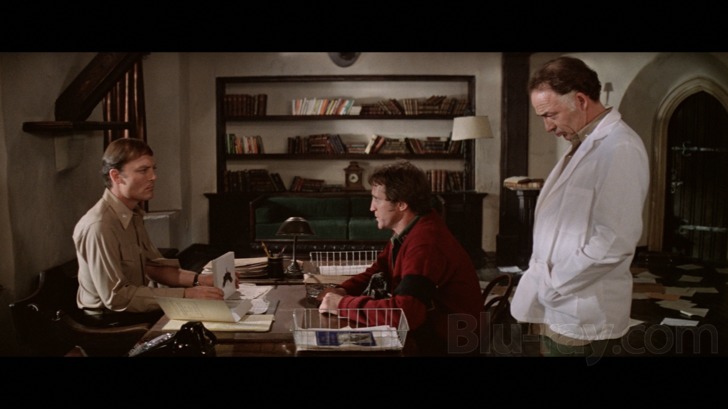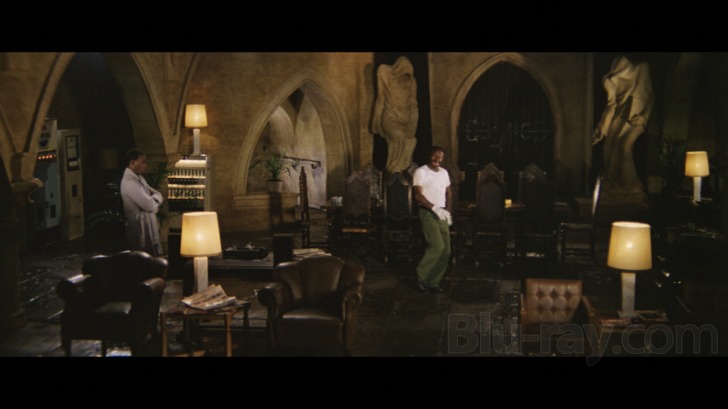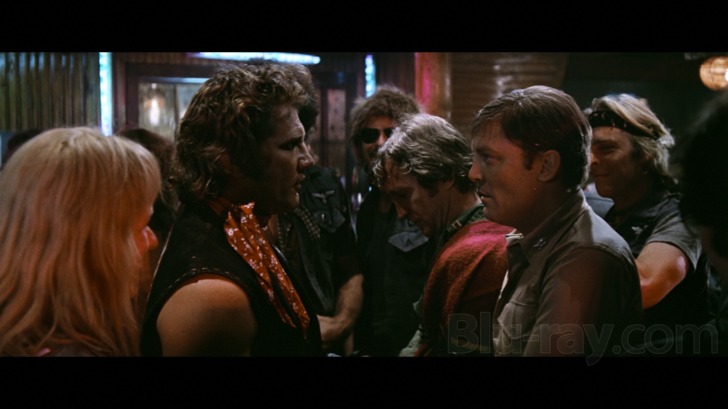The Ninth Configuration Blu-ray Movie
HomeThe Ninth Configuration Blu-ray Movie 
Twinkle, Twinkle, "Killer" Kane / Blu-ray + DVDHen's Tooth Video | 1980 | 118 min | Rated R | Nov 04, 2014

Movie rating
6.9 | / 10 |
Blu-ray rating
| Users | 0.0 | |
| Reviewer | 3.5 | |
| Overall | 3.5 |
Overview
The Ninth Configuration (1980)
In the final days of the Vietnam War, a psychiatrist, Col. Kane, takes charge of an experimental military facility studying soldiers who appear to have suffered a psychotic break. Kane believes he can cure the inmates, but his methods are challenged both by the military men guarding the facility and by the patients themselves, some of whom suspect that Kane isn't what he seems.
Starring: Stacy Keach, Jason Miller (I), Scott Wilson, George DiCenzo, Ed FlandersDirector: William Peter Blatty
| Mystery | Uncertain |
| War | Uncertain |
| Dark humor | Uncertain |
| Thriller | Uncertain |
| Drama | Uncertain |
Specifications
Video
Video codec: MPEG-4 AVC
Video resolution: 1080p
Aspect ratio: 2.39:1
Original aspect ratio: 2.39:1
Audio
English: DTS-HD Master Audio 2.0 Mono (48kHz, 24-bit)
Subtitles
English
Discs
50GB Blu-ray Disc
Two-disc set (1 BD, 1 DVD)
DVD copy
Playback
Region A (locked)
Review
Rating summary
| Movie | 3.0 | |
| Video | 3.5 | |
| Audio | 3.5 | |
| Extras | 3.0 | |
| Overall | 3.5 |
The Ninth Configuration Blu-ray Movie Review
Does God Laugh With Us or At Us?
Reviewed by Michael Reuben November 6, 2014William Peter Blatty is best known as the writer of The Exorcist (both novel and screenplay) and producer of the film, who famously clashed with its fiery-tempered director, William Friedkin. Exorcist afficionados also know Blatty for writing and directing what came to be called, against his wishes, The Exorcist III, based on his novel Legion. Like the original Exorcist, the film that Blatty would have preferred to call "Legion" was a supernatural thriller, but it was only modestly successful. Few fans know, however, that there is a third film in what Blatty calls his "trilogy of faith". First released in 1980 between The Exorcist and The Exorcist III under the title The Ninth Configuration, this third film quickly disappeared from view. Part of the problem grew from Blatty's insistence that Warner Bros., the initial distributor, not use the cachet of his reputation as a horror writer to advertise the new film. When Warner Bros. failed to comply, Blatty cancelled their distribution deal—and thus initiated a long odyssey of partial and failed releases, which was complicated by Blatty's constant editing and re-editing of the film, even changing the title at one point to "Twinkle, Twinkle, 'Killer' Kane", the name of the short comic novel he had written in 1966, then rewritten in 1978. (Does anyone sense a pattern here?) Part of the problem, however, was the nature of the film itself, a point that should be obvious from the fact that Blatty could not seem to finish the story, whether in print or on celluloid. The Ninth Configuration isn't quite like anything else. It doesn't have a model or an antecedent. It borrows from numerous genres, but it's as personal a film as one can possibly imagine. If any work has ever demonstrated the adage that films aren't finished, just abandoned, it would be The Ninth Configuration. If Blatty's entire cast were still alive, he might still be filming. It's easy to forget that, before The Exorcist typecast him as a purveyor of horror, Blatty was considered a comic writer. Among other things, he co-wrote with Blake Edwards one of the funniest of the Pink Panther movies, A Shot in the Dark. The Ninth Configuration shares much of the same farcical spirit, as exemplified by the long running gag in which the character played by Jason Miller (Father Karras in The Exorcist) attempts to rewrite and recast Shakespeare's plays for dogs. In deadpan earnest, he wonders aloud whether it's too obvious a choice to have Hamlet played by a Great Dane. But as much as Blatty enjoys the comedy, underneath it all he wants to ask big questions, arguably too big for the Pythonesque collision of sight gags and punchlines of which so much of the film consists. Does God exist? Why is there evil? Can sinners be redeemed? Is there life after death? Some viewers may find The Ninth Configuration intolerable, because it poses such questions so literally and directly. Then again, as with every other bizarre thing the film does, why not try it and see what happens?

The Ninth Configuration has a plot, but it's not one that you have to accept as likely or probable. The film is more like a tragi-comic parable told by a crazed acting troupe whose director can barely keep them under control. Everything about the film is excessive, outlandish and theatrical, including the biker bar where a crucial sequence occurs and that resembles not so much a real hangout as an intellectual's nightmare derived from exploitation films. Adding to the sense of dislocation is the fact that a film set primarily in the Pacific Northwest, with scenes in Vietnam, Washingon, D.C. and on the lunar surface, was shot entirely in Soviet-era Budapest, because of a financing deal with Pepsi-Cola, which wanted to build a plant there. It's the Vietnam War, and the military has established secret research facilities to study the high incidence of apparent psychosis among soldiers with no history of psychiatric problems. The most experimental of these facilities, designated as "No. 18", is housed in an abandoned castle somewhere in the forests of the Pacific Northwest. (Supposedly, the castle was once occupied by an eccentric tycoon who had the structure brought over from Europe.) In addition to military personnel, the inmates include a former astronaut, Capt. Billy Cutshaw (Scott Wilson), whose breakdown forced the cancellation of a mission to the moon. Cutshaw is the most aggressive and confrontational in a group that is notable for its undisciplined antics. Lt. Frankie Reno (Miller) is working on his canine Shakespeare with the assistance of fellow inmate and "casting director", Lt. Spinell (Joe Spinell, who played Willi Cicci in The Godfather: Part II and co-wrote and starred in Maniac). Lt. Benish (Robert Loggia) believes that he's from Venus; he can also sometimes be found performing Al Jolson songs in blackface. Capt. Fairbanks (George DiCenzo) insists that he has multiple personalities, each one of which he announces, although they all seem to behave violently. Maj. Nammack (Moses Gunn) attempts to be the first black Superman, drawing an "S" on his clothing, except when he finally dons a real Superman costume, where the "S" is replaced by a giant "N". Lt. Fromme (Blatty, uncredited) keeps stealing medical scrubs and masquerading as a psychiatrist, accompanied by other inmates dressed up as attendants, ER techs or a surgical team, as circumstances dictate. The attending physician, Col. Richard Fell (Ed Flanders), struggles to keep a lid on the chaos; so he is especially glad to greet a new chief psychiatrist, Col. Hudson Kane (Stacy Keach), who arrives to take charge of the facility. Soft-spoken but oddly distracted, Kane is clearly a troubled man. Both the inmates and the guards sense that he's not a typical therapist. The chief guard, Maj. Marvin Groper (Neville Brand), thinks he's too soft on the inmates, who, in Brand's opinion, are all goldbrickers. One guard in particular, Sgt. Krebs (Tom Atkins), can barely summon a show of respect for a superior officer when he speaks to Kane. Capt. Cutshaw, whose first instinct is to challenge any authority, confronts Kane directly with fundamental questions about sanity, life and morality. Against Cutshaw's expectation, Kane takes him seriously. Their exchanges are the film's intellectual and spiritual core, and they are also the main vehicle through which Blatty explores the twin mysteries central to the plot: Who is Kane and what is his purpose at the facility? Why did Cutshaw crack just before the moon launch, and can he be healed? As it turns out, both men are deeply religious—they even go to church together—but Kane is a man of faith, while Cutshaw honors God through doubt. (There is no greater acknowledgment of authority than challenging it.) One of the film's most famous images is that of an astronaut on the surface of the moon staring up at an image of Christ's crucifixion. The title of the film, Cutshaw's fear of space flight and the source of Kane's faith are all connected to that image, whose bizarre juxtaposition of the Christian savior, modern technology and the vastness of space is typical of Blatty's style throughout. The debate between Cutshaw and Kane reaches its unlikely climax in the biker bar mentioned earlier, where Kane must rescue Cutshaw after he is recognized as the cowardly astronaut whose picture appeared in all the papers and becomes an object of mockery and bullying. In its basic outline, the sequence is a classic vigilante/revenge story, as a bunch of hooligans get their just desserts. Because of everything that's led up to it, however, the sequence and its aftermath also play at a different level, one in which Kane shows Cutshaw the true meaning of sacrifice and a glimpse of the divine. As hokey and contrived as much of The Ninth Configuration may seem, one has to acknowledge Blatty's achievement in fusing such an unlikely genre convention with such weighty intellectual freight. As noted in the introduction, Blatty cut and recut the film repeatedly in the years after its initial release, including several versions for home video. Depending on where and when you have seen it previously, the version on this Blu-ray may not be the one with which you are familiar. Although Blatty says in the commentary that he might add another twenty minutes back to the film someday, he apparently never did so. This 118-minute version has remained, since 2002, his approved cut.
The Ninth Configuration Blu-ray Movie, Video Quality 

The Ninth Configuration was shot by British cinematographer Gerry Fisher (Highlander, Juggernaut), who astonished Blatty with the speed at which he worked at lighting scenes. This may help account for the grainy texture of many shots in the film, because the slower anamorphic lenses of the era needed substantial light to register a smooth and fully resolved image. In the era before high-resolution home video formats, there was far less concern about visible grain on theater screens. Another source of visible grain was Blatty's heavy use of smoke to create the foggy atmosphere in and around the castle and sets that served as facility No. 18, as well as his penchant for shooting in the rain. The film's opticals (e.g., the scenes on the lunar surface) also show accentuated grain due to the limitations of the effects technology before the digital era. Despite these source-based issues, the image on Hen's Tooth's 1080p, AVC-encoded Blu-ray is such a dramatic improvement over Warner's wan DVD release of The Ninth Configuration that fans should rejoice and newcomers should welcome the opportunity to experience this unique work in probably the best condition they're likely ever to see it. I do not want to raise false expectations, though; The Ninth Configuration is not Blu-ray "demo" material and almost certainly never could be. The source shows some minor wear and tear, and the image lacks any sense of "pop" and frequently loses fine detail in the smoke or the shallow depth of field of the anamorphic lenses. Blatty is far more interested in performances and editing rhythms than in visual perfection (a quality he shares, to some extent, with William Friedkin). One of the disc's strongest features is its colors, which were weak and washed-out on the Warner disc. Here, the military fatigues in various shades of olive and khaki stand out distinctly from the browns and grays of the castle walls and grounds; the shades of red that frequently identify Cutshaw register distinctively; the rainbow of colors in the stained-glass windows when Cutshaw and Kane attend church are vivid; and the cold neon hues of the biker bar establish a sharp contrast with the warmer tones of the psychiatric facility. Blacks are deep and solid, and whites are strong without excessive contrast. What the film's visual design lacks in detail, it makes up for in color, and this Blu-ray delivers on that point as well as I could have hoped. Hen's Tooth has provided The Ninth Configuration at an average bitrate of 29.99, which is a healthy apportionment of bandwidth for an image that frequently displays heavy grain and has many complex images with multiple moving elements in the frame.
The Ninth Configuration Blu-ray Movie, Audio Quality 

The audio history of The Ninth Configuration is almost as muddled as its many versions. As best as I have been able to determine, when Warner initially released the film to theaters, it had a stereo mix, and there was also a 70mm blow-up with a multi-track mix, either five- or six-channel. Neither of these appear to have survived the flurry of Blatty's recuts in the succeeding years. Either because of limitations in the source materials or to save expense (or both), all or most subsequent versions of the film had mono tracks. The 118-minute "final" cut on this Hen's Tooth Blu-ray has a mono track presented in DTS-HD MA 2.0, with identical left and right channels. The mono is very good quality, though, because it captures the essential character of Blatty's mix, which is a cacophony of competing voices delivering punchlines, psychotic raving, philosophical rambling, essential dialogue and Barry De Vorzon's (The Exorcist III) disquieting score in a kind of waking nightmare. Dynamic range is quite good for the period and the source, although opportunities for deep bass extension are rare (a rocket launch is a notable example). The track achieves greater impact with abrupt eruptions of silence, as when a character awakens from a troubling dream (if it was a dream). In the climactic biker bar fight, the sounds of the jeering crowd, of chains rattling and of body blows register with sufficient impact to make their point, although they're underwhelming compared to today's amped-up surround tracks.
The Ninth Configuration Blu-ray Movie, Special Features and Extras 

The extras are identical to those on Warner Bros. 2002 DVD release of The Ninth Configuration, which was itself a port of the version released by independent distributor Blue Dolphin Films in the U.K.
- Commentary with Writer/Director William Peter Blatty: With film critic Mark Kermode serving as interviewer and prompter, Blatty discusses all aspects of the film, from its origins to casting, financing and production, through its troubled release history and the many different versions. The commentary is an invaluable source of information and perspectives on The Ninth Configuration, but as one knows from the history of The Exorcist, Blatty and his collaborators often recall things differently. It would be interesting to hear what others involved in the production have to say (though, as Blatty sadly notes, many of them had already passed away when the commentary was recorded at least thirteen years ago).
- Featurette with Mark Kermode (480i; 1.85:1; 6:47): Kermode provides a brief introduction to the film and its unusual history. Blatty appears in interview clips.
- Outtakes & Deleted Scenes (480i; 1.85:1 & 2.35:1; 20:46): Unlike the Warner DVD, the Blu-ray does not allow the scenes to be selected individually, but it retains the DVD's titles and the introductory text screens explaining the history of each scene (with minor changes to reflect that the text no longer appears on a Blue Dolphin DVD). The titles are listed below, with a few edits to avoid spoilers. Each scene does have its own chapter stop. Blatty discusses several of these scenes (and many more) in his commentary:
- Winged Generals and Crucified Angels
- The Outrageous Mr. Groper
- Everyone's a Fruit and Nut Cake
- "Green Soaked Caterpillar Torturing Bastards"
- Spinell Goes to the Dogs
- Kane's Great Sacrifice
- Kane's Letter
- Coming Home
The Ninth Configuration Blu-ray Movie, Overall Score and Recommendation 

As with another, entirely different film I reviewed recently, Steven Spielberg's 1941, assigning a numerical score to The Ninth Configuration is a pointless exercise. Spielberg's film is utterly frivolous, and Blatty's, for all its cut-ups, is deadly serious, but both are films that make their own rules and insist that the viewer either play along or walk on by. Both are cult films, though Spielberg, as a major figure in cinema of this century and the last, is able to command a much larger cult than just about any other director. The Ninth Configuration is an ideal addition to Hen's Tooth's eclectic catalog of films that would otherwise never see the Blu-ray format, and this admirable rescuer of obscurities has done an impressive job of bringing a one-of-a-kind experience to Blu-ray. Highly recommended for existing fans; the rest of you, well, you've been warned.
Similar titles
Similar titles you might also like

The Killing Room
Experiment Killing Room
2009

Marrowbone
The Secret of Marrowbone
2017

Unsane
2018

Stonehearst Asylum
Eliza Graves
2014

The Other
Limited Edition to 3000 - SOLD OUT
1972

Irresistible
Slipcover in Original Pressing
2006

Combat Shock
1984

Proxy
2013

Daniel Isn't Real
Slipcover in Original Pressing
2019

Endless Night
1972

They Look Like People
Slipcover in Original Pressing
2015

Schizo
1976

Isle of the Dead
Warner Archive Collection
1945

The Hole
2001

The Haunting of Hill House
Extended Director's Cut
2018

Get Out 4K
2017

Dream House
2011

You Should Have Left
2020

The Skeleton Key
2005

Manhunter
Collector's Edition
1986
